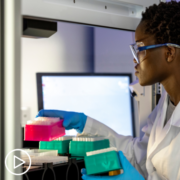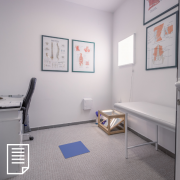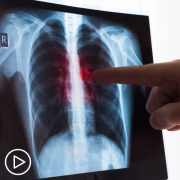Factors That Guide a DLBCL Treatment Decision
Factors That Guide a DLBCL Treatment Decision from Patient Empowerment Network on Vimeo.
What factors impact diffuse large B-cell lymphoma (DLBCL) treatment decisions? Expert Dr. Robert Dean shares key considerations, such as a patient’s health and risk factors, in determining DLBCL treatment options.
Dr. Robert Dean is a hematologist/medical oncologist at Taussig Cancer Institute at the Cleveland Clinic. Learn more about Dr. Dean, here.
See More From The Pro-Active DLBCL Patient Toolkit
Related Programs:

|

|

|
Transcript:
Katherine:
What are the main factors you take into consideration before a treatment approach is decided on?
Dr. Dean:
From the perspective of the biology of the lymphoma itself, it’s making sure that the tissue samples have been worked up in a thorough enough way to give us the information that we’ve already been discussing, especially to rule out or to identify when there’s a double-hit kind of chromosomal change in the lymphoma cells because for most patients that abnormality does call for a different approach from the usual R-CHOP treatment.
And not all treatment centers are equipped to give those more intensive treatments. So, someone who’s got a standard and, what I would consider to be a lower-risk case of large B-cell lymphoma, could be served very well receiving standard outpatient R-CHOP chemotherapy under the care of a local oncologist who’s taking care of patients in their community.
But someone who’s got a higher-risk situation, like a double-hit large cell lymphoma, would probably be better served to at least be seen in consultation by someone who’s got more specialized expertise in treating higher-risk lymphoma patients at a referral center. Beyond that, you have to also take into account a number of patient factors. Because diffuse large B-cell lymphoma is potentially curable with standard treatments, even the high-risk cases that’s true.
The first question that I always ask myself when I’m evaluating a new patient is, “is there anything about this person’s health that would make it impossible or highly risky for them to tolerate the standard treatments that we use to try to cure our patients?” If they’re a candidate for curative-intent treatment, then we decide what the most appropriate treatment would be from there.
The second question is, as we talked about before, is R-CHOP a reasonable standard approach for that patient, or do they have other risk factors that would suggest that you’d need to do something different, such as rituximab and EPOCH treatment or another more intensive regimen for a double-hit case? There’s a subgroup of patients who have large cell lymphoma that arises in the testicle in men and those patients are at increased risk for having the lymphoma show up later as a recurrence in the nervous system. There are studies that suggest that if you add some elements to the treatment to try to prevent that, that it may reduce that risk.
Katherine:
Okay.
Dr. Dean:
And then I think the last thing I would say is, with any patient I consider, are they eligible for a clinical trial that’s looking at a novel approach to treating large cell lymphoma and, if there is a clinical trial that they’d be eligible for, is that a good fit for their situation?
We know that our best treatment approaches that we currently have for standard of care right now still don’t prevent relapses in some patients and we want to continue to be able to offer our patients better treatment approaches and the only way that we can do that is by testing new ideas in clinical trials. So, I always ask myself, “Is this patient eligible for a trial, and do we have a trial or do I know of a trial that would be a good fit for them?”









